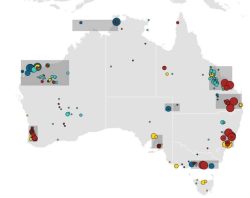A new report has revealed how Net Zero Zones could be created across Australia to bring together energy producers, emissions reduction technologies, manufacturing and industry to boost the net zero economy transformation.
The nine zones – based around existing resources, industrial and manufacturing regions – could be established with shared infrastructure for natural gas, renewables, carbon capture utilisation and storage (CCUS) technology and low-carbon hydrogen production.
The report found that the zones could cover 79 per cent of the 215 facilities captured by the Federal Government’s Safeguard Mechanism and 92 per cent of their greenhouse gas emissions.
Possible zones could be located in Adelaide-Port Augusta and the Cooper Basin in South Australia; Perth and the Pilbara in WA; Melbourne-Gippsland in southern Victoria; Sydney-Newcastle in NSW; Brisbane and the Surat Basin as well as Central Queensland; and the planned Middle Arm Sustainable Development Precinct near Darwin.
The zones, pictured below, are conceptualised in A Review of Net Zero Energy & Industrial Zones, an interim scoping study developed by the Australian Petroleum Production and Exploration Association (APPEA) with technical support from the Commonwealth Scientific and Industrial Research Organisation (CSIRO) to guide thinking and planning as part of the debate over how Australia reaches net zero.

APPEA will use the review’s analysis as a foundation for discussions and engagement with governments, industry and stakeholders across the regions.
The report’s release comes ahead of the 2023 APPEA Conference & Exhibition, with the theme Lead, Shape, Innovate – Accelerating to Net Zero, to be held in Adelaide this week.
APPEA Chief Executive Samantha McCulloch said: “Net Zero Zones could help Australia accelerate to net zero and seize the economic opportunities of the energy transformation.
“In a way, it’s like carpooling carbon emissions by working together to help achieve net zero in the fastest and most cost-efficient way for the economy.
“The zones could become magnets for regional investment and provide a framework for different industries to work together to speed up the path to net zero; reduce costs; create and protect jobs in manufacturing, mineral processing and industry; leverage existing infrastructure; provide a focal point for streamlined government approvals; and provide the foundation for net zero energy and industrial exports and imports.
“These zones would involve collaboration across different industries. It is about thinking wholistically about emissions reductions in these regions.
“Analysis confirms the important role of the gas industry and what it can contribute to the net zero challenge – cleaner energy and back up for renewable electricity while our infrastructure and expertise can help deliver step-change technologies such as CCUS and low-carbon hydrogen production.
“Leveraging existing infrastructure can ensure regions that powered the Australian economy to where it is today won’t be left behind as we restructure our economy for the future.
“The report highlights that equipping these nine regions with natural gas supply, firmed renewable energy, CO2 transport and storage infrastructure, and low-carbon hydrogen would provide the building blocks necessary to reach net zero in the fastest, most cost-efficient way.”
Attachment: .






